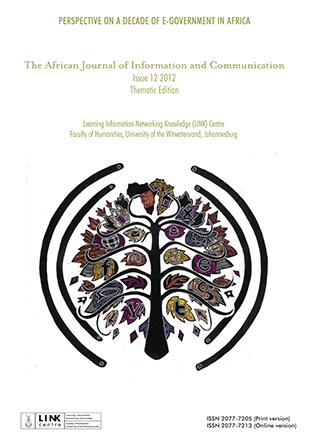Enabling g-Government in the Gauteng City-Region
DOI:
https://doi.org/10.23962/10539/19709Keywords:
effective government, g-government, GIS, spatial dataAbstract
The term g-government, a subset of e-government, was first introduced in 2000 as the convergence of geographical information systems (GIS) and the Internet to create more effective government interaction with citizens. More recently, it has been revised to describe the combination of GIS and Web 2.0 technologies that can enhance government services and delivery. Most government data is spatially based and can be visualised and interpreted using a Web GIS mapping application, but this data is often not available to other government departments, or the general public, frustratingly so. In South Africa, problems with accessing spatial data continue to exist. The Gauteng City-Region Observatory (GCRO) recognised that g-government remains a challenge within the Gauteng city-region (GCR), and in 2010 developed a GIS website for the GCRO and Gauteng Provincial Government. This article is presented in the context of the global shift to fully connected governments through technologies such as Government 2.0 and g-government. It provides a specific focus on the GCRO GIS website and how it enables g-government by providing local and provincial government with the spatial data and tools required to better understand the city-region, and to make informed decisions about future development in the city-region. The article also reviews Technology Acceptance Model (TAM) scores measured at the launch of the website. Finally, monthly website visits are examined. This confirms that local and provincial government are ready to utilise the g-government website.
References
Abbott, J. & Yoong, P. (2005). The stages of telecentre development: the case of the Kapiti telecentre. Technovation, Volume 25, No. 4, pp. 421-431. https://doi.org/10.1016/j.technovation.2003.12.003
Agbeja, O. & Salawu, R. (2007). Development in Sub-Saharan Africa: Overcoming the digital divide. Information Technology Journal Volume 16, No. 2, pp. 166-173.
Aji, Z., Mohd Yusof, S., Sheik Osman, W. & Yusop, N. (2010). A conceptual model for psychological empowerment of telecentre users. Computer and Information Science, Volume 3, No. 3, pp. 71-79.
Bird, D. & O’Connell, J. (2006). Behavioral ecology and archaeology. Journal of Archaeological Research, Volume 14, No. 2, pp. 143-188. https://doi.org/10.1007/s10814-006-9000-0
Bleed, P. (1997). Content as variability, result as selection: Toward a behavioural definition of technology. American Anthropological Association, Volume 7, No. 1, pp. 95-104. https://doi.org/10.1525/eth.1997.25.1.95
Crellin, I. (1994). The Australian telecentre program: A new approach to technology transfer and rural community development. 22nd International Conference of Agricultural Economists , Harare, Zimbabwe, 22-29 August, p. 14.
Ellen, D. (2003). Telecentres and the provision of community based access to electronic information in everyday life in the UK. Information Research, Volume 8, No. 2, available at: http://informationr.net/ir/8-2/paper146.html.
Gaiani, S., Hansson, H., Meegammana, N. & Mozelius, P. (2009). Critical issues for e-learning telecentres in Sri Lanka and India. ICDE World Conference on Open Learning and Distance Education, Maastricht, Netherlands.
Gómez Díaz, M. & Sandoval-Almazán, R. (2009). Tecnologías de la información y aprendizaje organizacional en telecentros. Revista Eletrônica De Sistemas De Informação, Volume 8, No. 2, pp. 1-22.
Hallberg, D., Kulecho, M., Kulecho, A. & Okoth, L. (2011). Case studies of Kenyan digital villages with a focus on women and girls. Journal of Language, Technology & Entrepreneurship in Africa, Volume 3, No. 8, pp. 255-273.
Hodder, I. (2001). Archaeological theory today. Polity, Cambridge.
Ibrahim, H., Yasin, A. & Dahalin, Z. (2010). Financial sustainability Issues in Malaysia’s telecentres. Computer and Information Science Volume 3, No. 2, pp. 235-240. https://doi.org/10.5539/cis.v3n2p235
Jensen, M. & Esterhuysen, A. (2001). The community telecentre cookbook for Africa, Recipes for self-sustainability: How to establish a multi-purpose community telecentre in Africa. United Nations Educational Scientific and Cultural Organization, Paris.
Government of Kenya (2007). Kenya Vision 2030. The popular version. Government of Kenya, Nairobi.
Kenya ICT Board. (2010). About Kenya ICT Board,. retreived 20 November 2010 from http://www.ict.go.ke/index.php?option=com_content&view=article&id=160&Itemid=182.
Larson, R. & Murray, M. (2008). Distance learning as a tool for poverty reduction and economic development: A focus on China and Mexico. Journal of Science Education and Technology, Volume 17, No. 2, pp. 175-196. https://doi.org/10.1007/s10956-007-9057-1
Naik, G. (2011). Designing a sustainable business model for e-governance embedded rural telecentres (EGERT) in India. IIMB Management Review, Volume 23, No. 2, pp. 110-121. https://doi.org/10.1016/j.iimb.2011.03.003
Ramos, A., Nangit, G., Ranga, A. & Triñona, J. (2007). ICT-enabled distance education in community development in the Philippines. Distance Education, Volume 28, No. 2, pp. 213-229. https://doi.org/10.1080/01587910701439254
Rogers, E. & Shukla, P. (2001). The role of telecenters in development communication and the digital divide. Journal of Development Communication: Special Issue on Telecenters, Volume 12, No.2, pp. 1-6.
Schiffer, M. (2002). Studying technological differentiation: The case of 18th-century electrical technology. American Anthropologist, Volume 104, No. 4, pp. 1148-1161. https://doi.org/10.1525/aa.2002.104.4.1148
Sharma, M. (2005). Information and communication technology for poverty reduction. The Turkish Online Journal of Distance Education, Volume 6, No. 2, pp. 16-23.
Terry, A. & Gomez, R. (2010). Gender and public access computing: An international perspective. The Electronic Journal of Information Systems in Developing Countries, Volume 43, No. 5, pp. 1-17. https://doi.org/10.1002/j.1681-4835.2010.tb00298.x
Downloads
Published
Issue
Section
License
Copyright (c) 2012 Chris Wray, Rex Van Olst

This work is licensed under a Creative Commons Attribution 4.0 International License.
How to Cite
- Abstract 224
- pdf 110


.png)